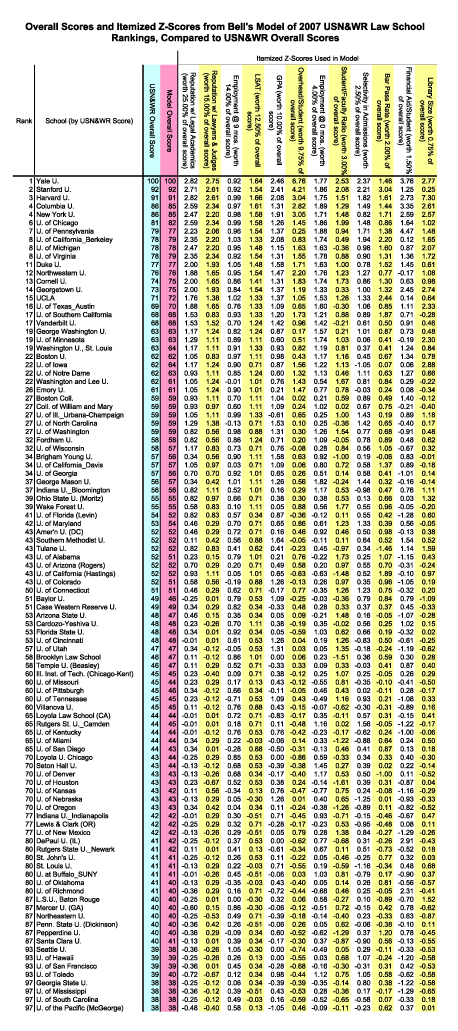
As I noted in my prior post, although the model does a pretty good job of duplicating USN&WR's results, the scores of a few schools diverge in notable—and puzzling—ways. Running regressions on the above data might help to explain the cause of those divergences. A regression might, for instance, quantify what casual observation suggests: Schools that got much lower scores in the model than in the USN&WR rankings tend to have relatively low z-scores in the "Expenditures/Student" category and relatively high ones in the "Financial Aid/Student" category.
That sort of analysis will have to wait, however. I need to take a break from blogging about the USN&WR rankings so that I can attend the American Association of Law School's Mid-Year meeting in Vancouver, Canada. I'm slated to present a talk at the Conference on New Ideas for Law School Teachers: Teaching Intentionally, entitled, "The Theory and Practice of Pedagogical Fun." Or perhaps I should say that I'm slated to perform; I plan to cap my talk by whipping out my guitar and singing "Excuses," the country-and-western-flavored song I wrote explaining the contract law defenses of mistake, frustration, and impracticability. It's my first gig! I'm terrified.
What with packing, travel, and practice, I'll find it hard to keep blogging about the USN&WR law school rankings. Soon, though, I'll wrap up the series with a post revealing the score curve for all the law schools ranked by USN&WR, a long-promised post summarizing some suggested reforms, and maybe a couple of other topics. In the meantime, I look forward to seeing some of my fellow legal academics in the Great Northwest.
[Please note that I've edited this post to reflect corrections that I made once and edits that I made to my model of the USN&WR rankings.]
Earlier posts about the 2007 USN&WR law school rankings:
- Change to U.S. News Law School Rankings Methodology
- "Financial Aid" Revised in U.S. News Methodology
- How USN&WR Counts Faculty for Rankings
- Whence Come the LSATs and GPAs Used in the Rankings?
- Gains and Losses Due to USN&WR's Use of Reported Median LSATs and GPAs
- How to Model USN&WR's Law School Rankings
- Why to Model USN&WR's Law School Rankings
- The ABA and USN&WR's Law School Rankings
- Accuracy of the Model of USN&WR's Law School Rankings
4 comments:
Prof. Jeffery E. Stake, not wanting to bother with all that Blogger asks of those who want to comment on the blogs it hosts, requested that I post his below comment on his behalf:
There has been some discussion on the issue of whether the weights used by USN&WR are the same as the variance attributable to the USN&WR
factors. Part of the reason for this discrepancy is that USN&WR did not always use the z-score method of weighting its factors. In particular, USN&WR adopted the z-score method in a year subsequent to the years that were studied by Klein and Hamilton in their report commissioned by the law deans. Joe Hoffmann and I reverse engineered the USN&WR process before this change, arriving at a formula that resulted in exactly the same ranks as published by USN&WR. Examination of that formula revealed that USN&WR was actually giving more weight to some factors than claimed. I warned readers of my Ranking Game website that USN&WR was using a method that did not properly scale the scores before combining them. Hoffmann and I informed the AALS of the strange method used by USN&WR and gave them our model to show them what USN&WR was doing. Perhaps coincidentally, the deans thereafter commissioned Klein and Hamilton to conduct their study finding that two factors accounted for most of the variance. Again perhaps coincidently, USN&WR changed their method after my criticism and the Klein and Hamilton report were published. The bottom line is that USN&WR has improved its method and there is little reason to believe that Klein and Hamilton's study would come out the same today.
[Dang! How do you post links in the comments on Blogger?]
By the way, you might find useful Prof. Stake's Law School Ranking Game website, at http://monoborg.law.indiana.edu/LawRank/.
My apologies to Prof. Stake. I misspelled his first name. It's "Jeffrey"--not "Jeffery."
Post a Comment